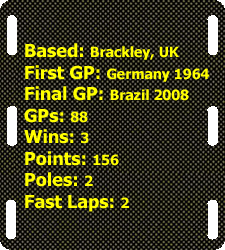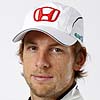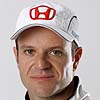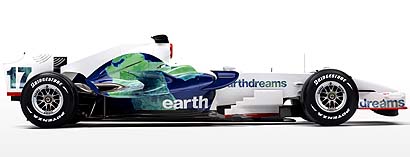|
Soichiro Honda was born in 1906 and l became an apprentice mechanic at a garage. He enjoyed some success as a racing driver with a special he built with friends and, just before WW2, went into the production of piston rings.
After the War he sold his small piston ring factory, became involved in a couple of non-motoring engineering projects, and then bought 500 small ex-military generators. He took the engines from the generators, clipped them to bicycles, and was on his way.
By 1962, Honda was the largest maker of motorcycles in the world and the first in history to produce more than a million units a year. It was in late 1962 that Honda offered its first mini-car for sale and it was little over 18 months later that a Honda first ran in Formula One.
What is remarkable about the decision is that Honda was the first motor manufacturer to run in Formula One since Mercedes-Benz, which had withdrawn in 1955, and that Honda's production of cars was still only just over 100 a week.
Soichiro Honda went racing to set challenges to his brightest engineers, to make them think laterally and quickly. He knew that the traditional Japanese culture of deference and conformity had to be by-passed if Honda was to succeed as a world player. At first Honda sent its V12 engine to Lotus with the idea of a Lotus-Honda partnership. Colin Chapman sat on the engine, both to delay Honda and to persuade Coventry Climax to build a new engine, which it did, the aborted flat-16.
Chapman's response persuaded Honda to build its own car, which it introduced at Zandvoort in 1964, and raced (for the first time) just a few days later in the German GP. Having failed to secure the services of former World Champion, Phil Hill, Honda opted for the relatively unknown Ronnie Bucknum.
The American crashed heavily, and consequently the team had to miss the next race (Austria), since it only had the one chassis. The Honda appeared in a number of races throughout the remainder of the season, but failed to score any points, or impress the other teams in the pitlane.
Things improved in 1965 when Bucknum was joined by another American, Richie Ginther. Although Ginther's career had been nothing to write home about, he was a good development driver, and that is exactly what the Japanese team needed.
A sixth place at Spa was followed by a strong performance at Zandvoort. Ginther wrapped up the season in perfect style when he took a well-deserved win in Mexico, with teammate Bucknum finishing fifth for good measure.
Honda had a new engine for the 3-litre formula and wanted to go into partnership with Brabham. Since Brabham was tied to Repco, Honda turned to the other driver who was both World Champion and an engineer, John Surtees.
Honda also turned to English manufacturer Lola, which produced an entirely new car for the Japanese team in under two months. A few weeks later the RA300 gave Surtees a surprise, and highly emotional, win at Monza.
The joy of Monza '67 was soon forgotten in 1968 when the team was clearly struggling. A new car, built of magnesium was introduced in the summer, but Surtees didn't like it, complaining that it simply not competitive.
There was also internal division on policy, Soichiro Honda wanted air-cooled engines, his engineers did not. Mr Honda got his way, of course, but the air-cooled Honda RA302 caused its driver, Jo Schlesser, to crash in its first race (Rouen), and he was killed. It meant an enormous loss of face to Honda, and at the end of the season it withdrew from F1.
In 1980 Honda returned to racing, this time with a Formula Two engine, which was offered to Ron Tauranac, who then was running Ralt. The success of the Ralt-Hondas led Honda to go into Formula One as an engine supplier. Honda would have gone with Ralt into Formula One but for a misunderstanding between Tauranac and Honda's chief engineer, Nobuhiko Kawamoto. It came down to a nuance of language, and changed the history of motor racing.
Between 1986 and 1991, Honda powered cars won every Constructors' Championship then, after 1992 Honda withdrew once more.
Honda returned to Formula One under the guise of 'Mugen-Honda'. Mugen is a company run by Soichiro Honda's son - Honda Sr. did not want to build a family dynasty within his own company for fear it would discourage the brightest recruits. The Mugen engines were actually designed by Honda and merely built by Mugen.
Honda also built at least one Formula One-style car as a 'design exercise' and a team went testing in 1998 under the supervision of Dr. Harvey Postlethwaite. The car went exceptionally well in testing and it seemed likely that a full works return was on the cards, then Honda cut its programme. One reason was Postlethwaite's sudden death, the result of a heart attack, a more compelling reason was a change of President.
Instead of proceeding with a works team, Honda announced that it would provide works engines to BAR from 2000 while Mugen-Honda would continue to supply Jordan Grand Prix, which it had been supplying since 1998, having supplied a number of other teams - including Prost, Ligier, Lotus and Footwork (arrows) during the 90s.
While Mugen-Honda dropped out a year later, Honda continued with BAR and Jordan, before opting, at the end of 2002, to focus all its efforts on BAR.
In late 2004, Honda bought a 45% stake in BAR from British American Tobacco, and promptly re-structured the team.
Despite having helped BAR to its best ever season - it finished runner-up to Ferrari - team boss David Richards was dumped in favour of Nick Fry, Richards' former colleague at Prodrive.
It was inevitable - given the changes the sport was undergoing - not to mention the anti-tobacco legislation being introduced worldwide, that eventually Honda would buy out British American Tobacco's remaining shares. And that is exactly what happened in late 2005.
Thus, in 2006, it was Honda Racing F1 Team that lined up on the grid in Bahrain, with BAR consigned to history, much like Minardi, Jordan, Prost…
Looking back, Honda will feel that all-in-all it wasn't such a bad season, indeed fourth place in the Constructors' Championship - ignoring the usual title talk hyperbole that accompanies almost every launch - wasn't too bad a result, especially when one considers that aero guru Willem Toet jumped ship to BMW just days into the new year.
However, there were times during the season when Honda must have wondered what on earth they'd gotten into.
Perhaps the story that best sums up Honda's first half of the season is the disaster that was Silverstone. When Jenson Button qualified nineteenth, spinning off into retirement next day. As the team struggled to come to grips with the fact that 'local hero' Jenson was not starting from the front of the grid but from the back, veteran commentator Murray Walker was regaling corporate guests of the team with tales of Michael Schumacher's genius.
At one stage Button visited the team's Brackley HQ in an attempt to raise morale, however, a couple of weeks later it was the Englishman who was in the doldrums having qualified nineteenth in France.
At the start of the season things looked promising, with Button never outside the first two rows in qualifying, and taking pole in Australia. However, teammate Barrichello was struggling, the Brazilian unable to come to terms with the Honda's traction control.
Shortly after the Silverstone debacle, Honda acted, appointing Shuhei Nakamoto to the role of senior technical director, which put technical director Geoff Willis in a difficult position.
No sooner had the team issued a press release stating that it was talking to Willis regarding a new role, than it was issuing a follow up stating that the Englishman was leaving the team by "mutual agreement".
According to Pitpass' sources, Willis was not only the fall guy, he was, in the eyes of many, one of the few people to offer Honda hope. In the months that followed, though Honda announced a couple of new signings, several key members of the team chose to head for pastures new.
After the messy mid-season dip, Honda put its considerable resources to work and suddenly the team looked capable of actually doing something. A second wind tunnel was brought on-line, giving the team a much need boost for the final races of the season and a springboard for 2007.
In Hungary, a number of demons were finally laid to rest, when Button brought his RA106 home to take an emotional victory. Not only had the Englishman finally broken his duck, his team had put the nightmare of Silverstone well and truly behind it.
The Hungaroring win gave both Button and the team a real kick, clearly stirring it on to greater things, with the Englishman and his teammate consistently scoring points in the final five races. Indeed, in the final five races of 2006 Button scored 25 points, more than he scored in the opening twelve races.
For 2007, both drivers were retained, with Christian Klien brought in to replace Anthony Davidson, who was heading to Super Aguri, as test driver, along with James Rossiter.
Following the impressive run-in to the 2006 season, much was expected in 2007. However, at one of the first pre-season tests, with the car well off the pace and looking a real handful, Button was heard to declare the RA107 a "piece of shit". Sadly, he was right and things didn't improve.
With word already going around the paddock that Honda would struggle in 2007, things weren't helped when the Brackley based outfit launched the car complete with a livery featuring an image of the globe and a PR campaign entitled 'Myearthdream'. While the team claimed that this was its own attempt to help save the planet, sceptics opined that it was a more likely face saving campaign to cover up the fact that the team had been unable to attract any serious sponsorship. Indeed, it is still believed that the 'Myearthdream' campaign was the remnants of failed bid to secure sponsorship from internet giant Google.
The livery, combined with the total lack of competitiveness of the RA107 led to some embarrassing moments for the team with headlines proclaiming how the earth didn't move for Button, while Pitpass was to subsequently refer to the Englishman's season as 'mypointsdream'.
While the team claimed that its problems were mainly due to aerodynamics, others said there was far more to it. Nick Fry continued to claim that the team was still "young" and "inexperienced", even though younger teams were out-classing the Brackley outfit, including, much to Honda's embarrassment, 'sister' team, Super Aguri.
Fry tried to put a brave face on things, citing the signing of new talent secured from rival teams, while omitting to point out the exodus through the back door.
In a season of low points however, one of the greatest was when the team invited the Beckhams to Silverstone, only to see them disappear up the grid to meet with Lewis Hamilton. To compound the misery, Button went off on the second lap.
A series of articles on Pitpass lead to threats of legal action from Fry and Honda, however, it was quite clear that the Japanese manufacturer had more on its mind than what a Formula One website had to say. Fact is, the articles were correct, the team was in crisis and at the root of the problem - other than a lack of serious leadership - was a major problem with the team's windtunnel.
Despite the many shortcomings of the equipment at their disposal, both drivers did their best, particularly Button. Following his success in late 2006, the Englishman was justified in expecting much more in 2007, but instead, in addition to facing problem after problem, he had to endure endless interviews that began with the dreaded words; "so Jenson, what do you think about Lewis Hamilton..."
Things were that much tougher for Barrichello, who, for the first time in his fifteen-season F1 career, failed to score a single point. For much of the year the Brazilian looked as though he was just about ready to throw in the towel.
More by luck than judgement, Button finished fifth in the lottery that was the Chinese GP, thereby allowing his team to save face by overhauling Super Aguri in the Constructors' Championship.
In addition to Button, against all expectations, Barrichello remained on board for 2008, while, in a bold move, Alex Wurz, one of the most experienced test drivers in the business, was recruited to kick start development.
The big signing however, was not that of a driver but of former Benetton and Ferrari Technical Director, Ross Brawn, who was given the role of Team Principal, with Nick Fry moved sideways to the role of Chief Executive.
We wrote ahead of the 2008 season: "The guys and girls at Brackley deserved better than what happened in 2007, we can only hope that under Brawn's leadership the team will prove that late 2006 was no flash in the pan." Little did we know.
To be fair, Brawn arrived too late to have any impact on the 2008 car, however, what we didn't know was that Honda would produce yet another dreadful car. The facts are that the RA108 scored points in only four races and for the second half of the season neither driver made it into the Top Ten qualifying shoot-out.
Honda's two senior aerodynamicists, Loic Bigois and John Owen, didn't arrive long before Brawn, so it was clear the team would struggle early on. However, the problems continued and it was soon clear that it was far more than a weak aero package. While the basic car was structurally good, the RA808E powerplant was one of the least powerful on the grid.
In pre-season testing, the car was well off the pace, however, a major aero upgrade for Melbourne saw Button and Barrichello close the gap, just a little. Indeed, the Brazilian finished fifth in the season opener but was subsequently disqualified for jumping a red light at the end of the pitlane.
The team struggled on, however, it was soon clear that 2008 was going to be another season in the points wilderness and therefore all efforts were concentrated on the 2009 car and the raft of new rules that would come with it. The lack of development of the RA108 meant the Japanese team fell further and further behind, however, a new rear suspension in the latter stages of the year saw a slight improvement and certainly did much in terms of team morale.
In addition to working on the 2009 car, Brawn focussed on re-shaping the team from the foundations up. He also restructured the relationship with Tochigi, feeling that the team was losing out as a result of competition between the two factories and also losing time waiting for decisions from Japan. In short, Brawn wanted things done his way, the way that led to titles with Benetton and Ferrari.
The drivers struggled on, though Barrichello appeared the more motivated. An inspired tyre call at Silverstone saw the Brazilian score his first podium visit since Indianapolis 2005.
With 14 points to its tally, Honda finished ahead of Force India and was at least spared the embarrassment of being eclipsed by Super Aguri since the popular Japanese outfit had gone bust just four races into the season.
While the Brackley outfit had suffered two dreadful seasons, there was an obvious air of optimism as the team looked ahead to 2009. Then came December 5.
Shortly after lunch, Pitpass received a call from a source at Brackley advising that a meeting was to take place later in the day. The source claimed that there was talk of lay-offs of cut backs, and even one wild rumour that Honda was to withdraw from F1.
A few hours later, the source called back, and Pitpass was the first media outlet in the world to reveal that Honda had indeed withdrawn from Formula One.
The Japanese manufacturer cited the global financial crisis, but as Pitpass wrote at the time, would Japan really have pulled the plug had Honda been winning races far less challenging for the title?
Honda gave the Brackley management three months in which to find a buyer, after which time, if no buyer had been found, the Brackley facility would be closed down. After numerous false starts, on March 6, almost three months to the day, it was revealed that Brawn had bought the team. With a brief press release, the Honda Motor Company brought its historic relationship with Formula One to a close.
There are some who believe the Brackley facility to be jinxed, Ross Brawn and his team will be desperate to prove this isn't true.
Meanwhile, there are many who remain convinced that Honda will be back. Time will tell. Certainly, this was no way to conclude the Honda F1 story.
|


























